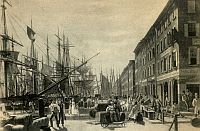
Ships on the East River — Once a City of Ships
Sometime during the Civil War, the poet Walt Whitman wrote a poem about New York City, titled “The City of Ships.” The first stanzas begin:
City of ships!
(O the black ships! O the fierce ships!
O the beautiful, sharp-bow’d steam-ships and sail-ships!)
City of the world! (for all races are here;
All the lands of the earth make contributions here;)
City of the sea! city of hurried and glittering tides!
City whose gleeful tides continually rush or recede, whirling in and
out, with eddies and foam!
For a period of roughly forty years from the opening of the Erie Canal to the end of the Civil War, New York City was one of the leading shipping centers of the world. The North Atlantic packet trade was dominated by New York ship owners, sailing fine packet ships built in New York ships yards. The Rainbow, the first extreme clipper ship, was built in New York, sliding into the East River from Manhattan’s Corlear’s Hook. The Young American, Sea Witch, Challenge, Comet and scores of others, which followed, would set records both for speed and profits. New York merchants earned vast fortunes in the China trade and the California clipper trade. Many New York institutions, from Columbia University to the Metropolitan Museum of Art were funded by money made in silk, porcelain and the opium trade. New York ship designers and builders Webb, Griffiths, Steers and others, were, for a time, the world’s finest, building ships powered by sail and steam. In the Civil War, Ericsson built the revolutionary battleship USS Monitor in just over 100 days in shipyards and engine works in Manhattan and across the East River in Greenpoint.
New York is a still a major harbor but is no longer Whitman’s “City of Ships.” Part of Whitman’s poem has survived as a railing in the North Cove Marina in downtown Manhattan on the Hudson River. Here is a video by Katherine Dill of Whitman’s poem showing the modern city, which notably, ironically, and sadly, lacks only, ships.

Thank you for this short and sweet reminder of the maritime tapestry of New York. I was enthralled by Walt Whitman’s ‘Leaves of Grass’ at age 13 and still consider him one of America’s greatest writers. It is to New York City’s credit that the man wrote a poem about it.
I can remember arriving in New York, Hoboken actually, in the early 1950’s as a young Deck Apprentice and seeing all the Liners berthed at the piers in Manhattan. When one arrived or sailed numerous tugs would be working around her with horns blasting and the Liners steam whistle thundering. Little did we know that we were seeing the end of an era and within ten years it was mostly gone. We used to sit out on deck at night when at anchor awaiting Clearance amazed at the lights of New York, New York. That huge sign in red of the coffee cup saying “Good to the last drop”. How lucky we were then and to have these memories today !!
Good Watch.
Thanks for posting the piece and the video. New York is the city of which we sing so often, in songs old and new, in the Shanty Sessions,at the Noble Maritime Collection on Staten Island, at New York Packet concerts, and at song sessions great and small throughout the Five Boroughs. The ships may be fewer and less “glamourous” than their sail-driven ancestors, but the romance of far-voyaging still attaches to them. It’s hard to find a more enjoyable way to spend some quiet time than just sitting beside the Harbor and watching the vessel traffic — good for the body, good for the soul.
Does anyone know how a packet ship made it’s way into berth along the East River, mid nineteenth century? Was this done by wind and tide or was she always towed or tugged? Thanks, ROB.
According to Harper’s New Monthly Magazine Volume 68 of 1884, “tug boats came into use about the year 1835, but being expensive were hired in case of emergency only.” Reading further, it appears that they are referring to being towed from the berth all the way across the bar beyond Sandy Hook. Given the currents in the East River, I find it hard to imagine docking or undocking without tugs, though that could be possible at slack water with the right wind.
http://books.google.com/books?id=0Y47AQAAMAAJ&pg=PA235&lpg=PA235&dq=packet+ship+tug+boat+east+river&source=bl&ots=J1IwYUSLLy&sig=GBHLqhrZDFnCEaQIEty62CbKqAw&hl=en&sa=X&ei=BGTcUpqVBuzlsATcioDwBQ&ved=0CC0Q6AEwAA#v=onepage&q=packet%20ship%20tug%20boat%20east%20river&f=false
Thanks. The article says it was a fine sight to see the packets come up the East River under sail and anchor off the pier. Would she be ledger in? I’m writing a novel in which a packet arrives from Liverpool in 1850. Help with this detail appreciated. Rob